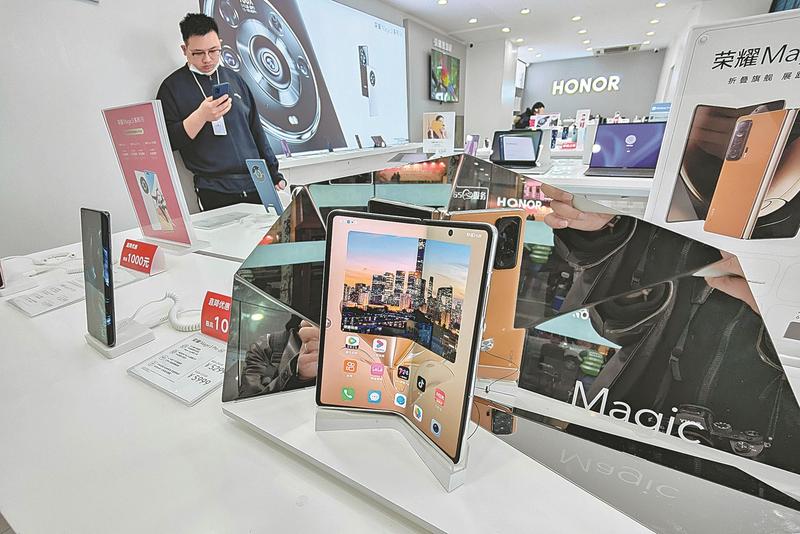 Honor's first foldable smartphone Magic V on display at a shop in Shanghai. (WANG GANG / FOR CHINA DAILY)
Honor's first foldable smartphone Magic V on display at a shop in Shanghai. (WANG GANG / FOR CHINA DAILY)
Smartphone chip shortages have eased to a certain extent, and supplies are expected to return to normal later this year, but weaker-than-expected demand is weighing down on the Chinese smartphone market, company executives and experts said.
Xu Qi, vice-president of Realme, an up-and-coming Chinese smartphone brand, said in an interview on Tuesday night that the shortage of mobile phone chips has been easing since the beginning of this year. Prices of some chips have declined, but it remains to be seen whether the overall cost of smartphones will drop.
According to Xu, competition in the Chinese mobile phone market will further intensify this year, judging from a larger-than-expected decline in local smartphone shipments in the first two months.
In February, smartphone shipments in China witnessed a year-on-year decline of 31.8 percent to 14.55 million units, according to data from the China Academy of Information and Communications Technology, a Beijing-based think tank.
Xu attributed the sharp decline to factors like a traditionally slack season after booming sales of the Spring Festival holiday, logistics challenges intensified by the COVID-19 pandemic, and the longer smartphone upgrade cycle.
The decline is short-term, and the market will improve later this year, Xu said. Realme maintains its target of achieving 50 percent year-on-year growth in sales volume this year, against a background of an estimated 30 percent year-on-year growth in the Chinese smartphone market, and more than 50 percent rise in overseas markets.
On Tuesday, Realme unveiled its Realme GT Neo3 smartphone series. The new handsets are tailor-made to attract gaming enthusiasts. Realme said it is keen to make the brand shine among young people as competition intensifies in the market.
Elsewhere, Wang Xiang, president of Xiaomi Corp, said in an earnings call on Tuesday that though ensuring chip supply is still challenging in the first quarter of this year, the company believes that chip supplies will return to normal later. There could even be an oversupply situation, he said.
Meanwhile, the pandemic posed more difficulties in logistics, but the company believes it is a short-term problem, Wang said.
Xiaomi posted a revenue of 85.6 billion yuan ($13.4 billion) in the fourth quarter of 2021, marking a 21.4 percent year-over-year rise, as it saw rapid growth in overseas markets and growing shipments of high-end smartphones.
Wang said despite challenges in the external environment and the COVID-19 pandemic, Xiaomi still has big room for growth.
"We'll promote sales of midrange to high-end products, which grew very fast last year. We sold 24 million units of high-end smartphones in 2021," Wang said.
Liu Xu, general manager of the Digital Economy Industry Research Center at CCID Consulting, said the COVID-19 pandemic has led to a structural supply imbalance, which has affected the smartphone industry for nearly two years.
Wang Bin, senior analyst of Beijing-based Urtrust Think Tank, said a lack of innovative products also affected sales.



